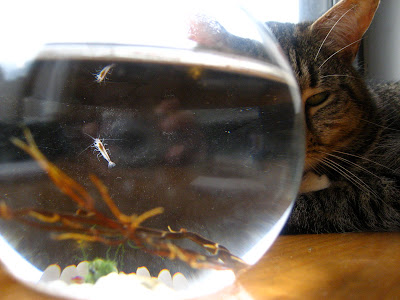
I'll just say it right upfront - lasagna is a pain in the ass. I'm not saying that it's a pain in the ass that isn't worth it in the end, but it does need to be said that lasagna is labor intensive. It also needs to be said that you need a lasagna pan to make a giant lasagna, and a regular baking dish is probably not a good idea unless you like a huge mess.
But anyway, I'll get to the mess later. The point is, lasagna has several components, all of which require separate preparation. First, the bechamel:

Easy to make, but when you don't have a dishwasher, it means another pot, another spoon. I highly recommend making the tomato sauce component of this element on another day to save yourself using every single one of your burners at the same time.
Second, the ricotta mixture:

Thankfully, no need for a burner here, but still another big bowl to wash.
Third, the meat:

The second burner in use. The third, of course, is the pasta itself. I could not have fit another pot on my stove. And here is where I give you an important tip:

Don't build a lasagna to heights greater than the sides of your pan:

It will be a mess. A delicious mess, sure, but I don't have a dishwasher. This was a bit of a disaster. However, there were a couple of big positives that came out of this lasagna, mostly the revelation that I actually prefer using lower fat versions of some of the elements - namely the cheeses and the beef - because I don't like really greasy lasagna. Recipe after the jump:
CLASSIC ITALIAN LASAGNA
Adapted from a recipe by Giada DeLaurentiis
Bechamel Sauce:
4 tablespoons unsalted butter
1/3 cup all-purpose flour
3 cups whole milk at room temperature
Pinch freshly grated nutmeg
2 cups tomato sauce, recipe follows
Salt and white pepper
3 tbsp extra-virgin olive oil
1 pound lean ground beef
Salt and pepper
1 1/2 pounds part-skim ricotta cheese
3 large eggs
1 pound lasagna sheets, cooked al dente (approx. 4-5 minutes)
2 packages (10 ounces each) frozen chopped spinach, thawed and squeezed dry
3 cups shredded past-skim mozzarella
1/4 cup freshly grated Parmesan
Preheat oven to 375 degrees F.
Bechamel sauce:
In a 2-quart pot, melt 4 tablespoons of butter over medium heat. When butter has completely melted, add the flour and whisk until smooth, about 2 minutes. Gradually add the milk, whisking constantly to prevent any lumps from forming. Continue to simmer and whisk over medium heat until the sauce is thick, smooth and creamy, about 10 minutes. The sauce should be thick enough to coat the back of wooden spoon. Remove from heat and add the nutmeg and tomato sauce. Stir until well combined and check for seasoning. Set aside and allow to cool completely.
In a saute pan, heat extra-virgin olive oil. When almost smoking, add the ground beef and season with salt and pepper. Brown meat, breaking any large lumps, until it is no longer pink. Remove from heat and drain any excess fat. Set aside and allow to cool completely.
In a medium sized bowl, thoroughly mix the ricotta and eggs. Season with salt and pepper. Set aside.
Into the bottom of a 13 by 9-inch deep lasagna dish, spread 1/3 of the bechamel sauce. Arrange the pasta sheets side by side, covering the bottom of the baking dish. Evenly spread a layer of all the ricotta mixture and then a layer of all the spinach. Arrange another layer of pasta sheets and spread all the ground beef on top. Sprinkle 1/2 the mozzarella cheese on top of the beef. Spread another 1/3 of the bechamel sauce. Arrange the final layer of pasta sheets and top with remaining bechamel, mozzarella and Parmesan cheeses.
Line a large baking sheet with aluminum foil. Place lasagna dish on top, cover and put on the middle rack of the oven and bake until top is bubbling, about 30 minutes. Remove cover and continue to bake for about 15 minutes.
Simple Tomato Sauce:
1/2 cup extra-virgin olive oil
1 small onion, chopped
2 cloves garlic, chopped
1 stalk celery, chopped
1 carrot, chopped
Sea salt and freshly ground black pepper
2 (32-ounce) cans crushed tomatoes
2 dried bay leaves
4 tablespoons unsalted butter, optional
In a large casserole pot or Dutch over, heat oil over medium high heat. Add onion and garlic and saute until soft and translucent, about 5 to 10 minutes. Add celery and carrots and season with salt and pepper. Saute until all the vegetables are soft, about 5 to 10 minutes. Add tomatoes and bay leaves and simmer uncovered on low heat for 1 hour or until thick. Remove bay leaves and check for seasoning. If sauce still tastes acidic, add unsalted butter, 1 tablespoon at a time to round out the flavors.
Add 1/2 the tomato sauce into the bowl of a food processor. Process until smooth. Continue with remaining tomato sauce.
If not using all the sauce, allow it to cool completely and pour 1 to 2 cup portions into freezer plastic bags. This will freeze up to 6 months.
Continue Reading "lasagna, a lesson in poor planning"













































